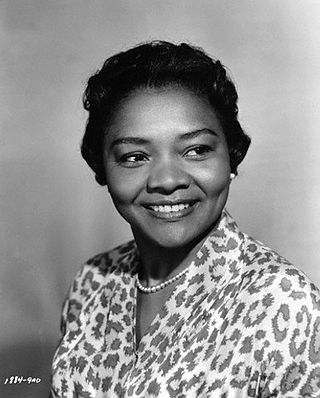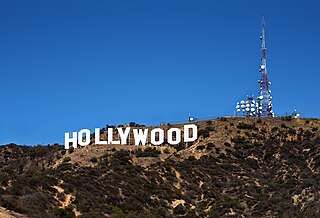Related Research Articles

Sidney Poitier was a Bahamian and American actor, film director, and diplomat. In 1964, he was the first Black actor and first Bahamian to win the Academy Award for Best Actor. He received two competitive Golden Globe Awards, a BAFTA Award, and a Grammy Award as well as nominations for two Emmy Awards and a Tony Award. In 1999, he ranked among one of the "American Film Institute's 100 Stars". Poitier was one of the last surviving stars from the Golden Age of Hollywood cinema.

Blackface is the practice of non-black performers using burnt cork or theatrical makeup to portray a caricature of black people on stage or in entertainment.

Hattie McDaniel was an American actress, singer-songwriter, and comedienne. For her role as Mammy in Gone with the Wind (1939), she won the Academy Award for Best Supporting Actress, becoming the first African American to win an Oscar. She has two stars on the Hollywood Walk of Fame, was inducted into the Black Filmmakers Hall of Fame in 1975, and in 2006 became the first Black Oscar winner honored with a U.S. postage stamp. In 2010, she was inducted into the Colorado Women's Hall of Fame.

Fredericka Carolyn "Fredi" Washington was an American stage and film actress, civil rights activist, performer, and writer. Washington was of African American descent. She was one of the first Black Americans to gain recognition for film and stage work in the 1920s and 1930s.

Juanita Moore was an American film, television, and stage actress.

The race film or race movie was a genre of film produced in the United States between about 1915 and the early 1950s, consisting of films produced for black audiences, and featuring black casts. Approximately five hundred race films were produced. Of these, fewer than one hundred remain. Because race films were produced outside the Hollywood studio system, they were largely forgotten by mainstream film historians until they resurfaced in the 1980s on the BET cable network. In their day, race films were very popular among African-American theatergoers. Their influence continues to be felt in cinema and television marketed to African-Americans.
The 12th Academy Awards ceremony, held on February 29, 1940 by the Academy of Motion Picture Arts and Sciences (AMPAS), honored the best in film for 1939 at a banquet in the Coconut Grove at The Ambassador Hotel in Los Angeles. It was hosted by Bob Hope, in his first of nineteen turns as host.

Stereotypes of African Americans are misleading beliefs about the culture of people with partial or total ancestry from any black racial groups of Africa whose ancestors resided in the United States since before 1865, largely connected to the racism and the discrimination to which African Americans are subjected. These beliefs date back to the slavery of black people during the colonial era and they have evolved within American society.

Viola Davis is an American actress and producer. Davis is one of the few performers to have been awarded an Emmy, a Grammy, an Oscar, and a Tony (EGOT). She is the sole black actress to achieve the Triple Crown of Acting as well as the third person to achieve both statuses. Time named her one of the 100 most influential people in the world in 2012 and 2017, and in 2020, The New York Times ranked her ninth on its list of the greatest actors of the 21st century. Her film breakthrough came with her role in the drama Doubt (2008), for which she received her first Academy Award nomination for Best Supporting Actress.

Octavia Lenora Spencer is an American actress. She is the recipient of several accolades, including an Academy Award, a British Academy Film Award, and a Golden Globe Award, and is the first black actress to receive two consecutive Oscar nominations.
Robert Stam is an American film theorist working on film semiotics. He is a professor at New York University, where he teaches about the French New Wave filmmakers. Stam has published widely on French literature, comparative literature, and on film topics such as film history and film theory. Together with Ella Shohat, he co-authored Unthinking Eurocentrism: Multiculturalism and the Media.
Ella Habiva Shohat is an Iraqi-born Israeli-American professor of cultural studies at New York University, where she teaches in the departments of Art & Public Policy and Middle Eastern & Islamic Studies. She has written and lectured on the topics of Eurocentrism, orientalism, post-colonialism, trans-nationalism, and diasporic cultures.

An ethnographic film is a non-fiction film, often similar to a documentary film, historically shot by Western filmmakers and dealing with non-Western people, and sometimes associated with anthropology. Definitions of the term are not definitive. Some academics claim it is more documentary, less anthropology, while others think it rests somewhere between the fields of anthropology and documentary films.

Aïssa Maïga is a Senegal-born French actress, director, writer, producer, and activist. Maïga has worked with major auteurs like Michael Haneke, Abderrahmane Sissako and Michel Gondry, and recently starred in Chiwetel Ejiofor’s directorial debut.

The Help is a 2011 period drama film written and directed by Tate Taylor and based on Kathryn Stockett's 2009 novel of the same name. The film features an ensemble cast, including Emma Stone, Viola Davis, Bryce Dallas Howard, Octavia Spencer, Jessica Chastain, Allison Janney, and Sissy Spacek. The film and novel recount the story of a young white woman and aspiring journalist Eugenia "Skeeter" Phelan. The story focuses on her relationship with two black maids, Aibileen Clark and Minny Jackson, during the Civil Rights Movement in 1963 Jackson, Mississippi. In an attempt to become a legitimate journalist and writer, Skeeter decides to write a book from the point of view of the maids, exposing the racism they face as they work for white families. Black domestic workers in 1960s America were referred to as "the help", hence the title of the journalistic exposé, the novel and the film. "The Help" brings to light the challenges and discrimination that African American people faced.
Whiteface is a type of performance in which a person of color uses makeup in order to appear fair-skinned. The term is a reversal of the form of performance known as blackface, in which makeup was used by a performer to make themselves look like a black person, usually to portray a stereotype. Whiteface performances originated in the 19th century, and today still occasionally appear in films. Modern usages of whiteface can be contrasted with blackface in contemporary art.

Negro Actors Guild of America(NAG) was formed in 1936 and began operation in 1937 to create better opportunities for black actors during a period in America where the country was at a crossroads regarding how its citizens of color would be depicted in film, television and the stage.

Inequality in Hollywood refers to the various forms of discrimination and social inequality in the American media industry. There are many branches of the media industry, such as news, television, film, music, agencies, studios, to name some of the major players. In each one of these branches, there are many instances of inequality since Hollywood formed as the entertainment hub of America in the early 1900s.

African American cinema is loosely classified as films made by, for, or about Black Americans. Historically, African American films have been made with African-American casts and marketed to African-American audiences. The production team and director were sometimes also African American. More recently, Black films featuring multicultural casts aimed at multicultural audiences have also included American Blackness as an essential aspect of the storyline.

Horror Noire: A History of Black Horror is a 2019 American documentary film directed by Xavier Burgin and based on the 2011 non-fiction book Horror Noire: Blacks in American Horror Films from the 1890s to Present by Robin R. Means Coleman. The film examines the relationship between African-American history and the evolution of the horror film genre, and the roles that African-American people have played in the genre's development. It features interviews with Coleman, along with such figures as actors Keith David, Tony Todd, and Rachel True, director Jordan Peele, and author Tananarive Due.
References
- 1 2 Staples, Brent (11 February 2012). "Black Characters in Search of Reality". The New York Times . Retrieved 25 April 2012.
- ↑ Guerrero, Ed (2012-06-20). Framing Blackness: The African American Image. Temple University Press. ISBN 9781439904138 . Retrieved 29 March 2012.
- ↑ "Blackface: The History of Racist Blackface Stereotypes" . Retrieved 29 March 2012.
- ↑ Stevens, Dana (27 November 2005). "Caricature Acting". The New York Times.
- ↑ Obenson, Tambay (2021-11-26). "'Something Good — Negro Kiss': Solving Its Historical Mystery and How to Account for 'Lost' Black Films". IndieWire. Retrieved 2021-12-01.
- ↑ Shohat, Ella and Robert Stam. Unthinking Eurocentrism: Multiculturalism and the Media, 2nd ed. London and New York: Routledge, 2014.
- 1 2 3 "The Icon and the Outcast: Hattie McDaniel's Epic Double Life". Vanity Fair . 26 April 2021.
- ↑ Dargis, Manohla (11 February 2011). "Hollywood Whiteout". The New York Times. Retrieved 25 April 2012.
- 1 2 Barnes, Brooks (19 October 2008). "Race and the safe Hollywood Bet". The New York Times . Retrieved 25 April 2012.
- ↑ Staples, Brent (2012-02-11). "Opinion | Black Characters in Search of Reality". The New York Times. ISSN 0362-4331 . Retrieved 2023-11-22.
- ↑ "The Oscars: Winners". Oscar. Archived from the original on 19 February 2017. Retrieved 29 May 2014.
- ↑ "Moviegoer Demographics: Who rules the movie audience statistic?". Demographic Partitions. Archived from the original on 16 November 2019. Retrieved 29 May 2014.
- 1 2 3 Prospero (21 January 2016). "How racially skewed are the Oscars?". The Economist. Retrieved 31 July 2017.
- 1 2 3 4 5 6 7 8 Shohat, Ella and Robert Stam. Unthinking Eurocentrism: Multiculturalism and the Media London: Routledge, 1994.
- 1 2 Dyer, Richard. White: Essays on Race and Culture. London and New York: Routledge, 1997.
- ↑ Bristor, Julie; Lee (1995). "Renee". Public Policy & Marketing. 1. 14: 48–59. doi:10.1177/074391569501400105. JSTOR 30000378. S2CID 159373453.